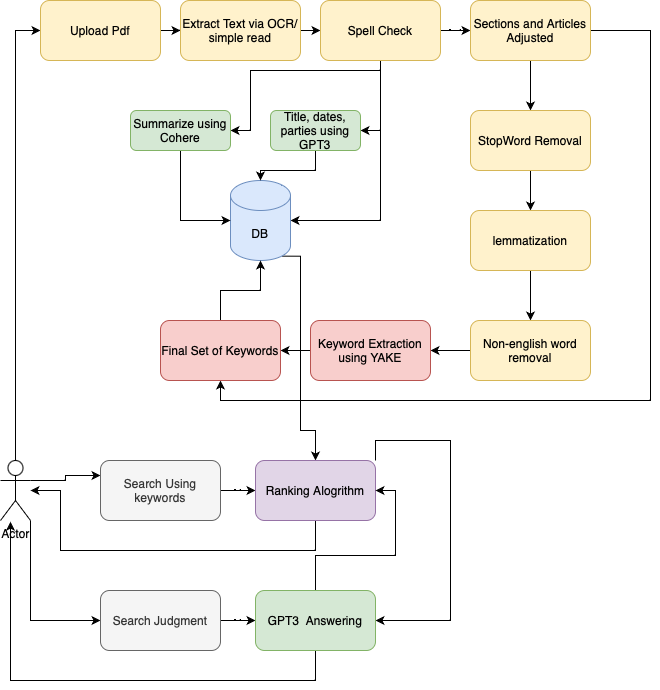Introducing Nirnayaak: The AI behind Revolutionary Web Application Simplifying Legal Research
An MLH Hackathon Winner
Table of contents
Are you tired of sifting through piles of legal documents and case files, trying to find the information you need? Do you feel like you need a degree in law just to understand the jargon and legalese? Well, fret not, my friend! Nirnayaak is here to save the day!
But wait, there's more! Nirnayaak isn't just for lawyers and judges. It's also helpful for law students and hobby practitioners, and it's a great source of knowledge for common citizens. Whether you're a legal expert or just someone who wants to know the right legal actions to take in certain situations, Nirnayaak is the perfect tool for you.
One of the key features of Nirnayaak is its ability to help users search for cases using keywords. All you need to do is type in your query in natural human language form, and Nirnayaak will show you previous cases linked to your query and their verdict. This feature is especially helpful for law students and hobby practitioners who are just starting out in their legal careers.
Another exciting feature of Nirnayaak is its ability to upload PDFs of cases. This feature makes it possible for judges and lawyers to upload their cases, making it a valuable resource for legal professionals. Additionally, common citizens can use the website for knowing the right legal actions to take in some situations.
Nirnayaak also offers authorization and authentication features, which ensure that only authorized users can upload cases and access the data. This feature makes it a reliable and trustworthy source of legal information.
The web application also provides keywords for auto-complete, which makes searching for cases even faster and more efficient. Additionally, it has a sorting algorithm for search results, which ensures that the most relevant cases are displayed first.
Why Use Nirnayaak?
There are several reasons why Nirnayaak is a valuable resource for legal research. Firstly, it is estimated that there are currently 79,000 cases pending in the Supreme Court and 59,00,000 cases pending in High Courts in India alone. With such a massive backlog of cases, finding the right information can be a tedious and time-consuming task. Nirnayaak simplifies this process and makes it easier for legal professionals and students to access the information they need.
Another reason to use Nirnayaak is the number of cases lost due to bad sentencing. In 2021, it was reported that 68,000 cases were lost due to bad sentencing. This number is alarming and highlights the need for more accurate and efficient legal research tools. Nirnayaak’s use of Artificial Intelligence and its advanced search capabilities can help reduce this number significantly.

The Architecture in detail

The architecture of Nirnayaak is designed to ensure fast and accurate retrieval of legal information, with the help of advanced technologies such as Artificial Intelligence, Natural Language Processing, and Machine Learning. Here is a more detailed explanation of the architecture:
Upload PDF: When a user uploads a PDF document, Nirnayaak uses Optical Character Recognition (OCR) technology to read the PDF contents. If the PDF is an image, the application runs OCR to convert it to text format. The OCR is followed by a spell check to ensure accuracy, and sections and articles are adjusted manually to improve the readability of the document.
Stopword Removal and Lemmatization: The application performs manually curated stopword removal, which means that it removes the most common words in the English language (such as “a”, “an”, “the”, etc.) from the document. This step helps to reduce noise in the data and improve the accuracy of the search results. The application also performs lemmatization, which involves reducing words to their base form. For example, the word “running” is reduced to “run”, “jumping” is reduced to “jump”, and so on. This step helps to standardize the text and improve the accuracy of the search results.
Non-English Word Removal: The application uses TextBlob, a Python library for processing textual data, to remove non-English words from the document. This step ensures that the search results are relevant and accurate for users who are searching in English.
Keyword Extraction: The application uses YAKE (Yet Another Keyword Extractor), a multi-lingual, context-sensitive keyword extraction algorithm, to extract relevant keywords from the document. This step helps to identify the most important terms and concepts in the document and improves the accuracy of the search results.
Summarization: After the spell check and keyword extraction are complete, the application summarizes the entire document using CoHere, an AI-powered summarization tool. CoHere uses Natural Language Processing (NLP) and Machine Learning (ML) techniques to generate a concise summary of the document. The application also takes out information like title, date, parties, etc. using GPT-3, an advanced language model developed by OpenAI.
User Queries: When a user types a query into Nirnayaak, the application searches the database using keywords and a ranking algorithm. The application fetches the most relevant results based on the search query and displays them in a user-friendly manner. If the question cannot be answered directly from the database, the application uses GPT-3 for answering. It fetches keywords, and the ranking algorithm and fetches the most relevant results.
Overall, Nirnayaak’s architecture is a sophisticated system that incorporates advanced technologies to provide fast and accurate legal research capabilities to users. By leveraging OCR, NLP, ML, and AI, Nirnayaak simplifies legal research and makes it more accessible to legal professionals, students, and the general public.
In conclusion, Nirnayaak is a game-changer in the legal research field. It's fast, efficient, and easy to use, making legal research accessible to everyone. So, what are you waiting for? Give Nirnayaak a try and see how it can make your legal research a breeze!
And waaaaaiiiit!! Follow me on GitHub. Thanks!
Also, follow these people who helped build this - Arya Chakraborty, Amit Samui, and Anurag Chakraborty
Original Site link: nirnayaak.co
Github repo: https://github.com/Codehackerone/nirnayaak.ai
My profile links: https://linktr.ee/soumyajit.d
